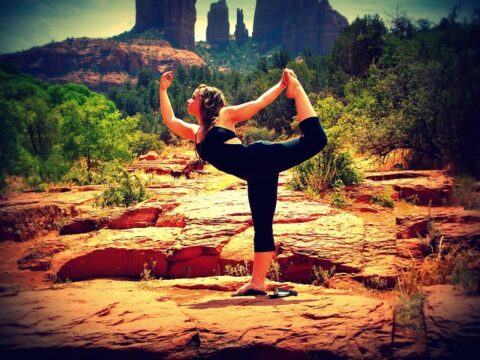Why improve posture? Apart from the aesthetic benefits of better posture, poor posture can also be detrimental to your health. It can cause pain in your back, neck, shoulders and even forehead. It can even make it difficult to move around and do activities you used to enjoy.
If you want to avoid these health problems and improve your overall functioning, you should try to learn good posture and correct your posture.
Good posture helps the body use energy more efficiently. It also prevents muscles from becoming overstretched and tired. It can also reduce back pain and improve your flexibility.
To improve your posture, you must first learn to recognise your movement habits. For example, if you are standing or sitting incorrectly, your hips should be even and your knees should be straight forward.
Podcast
This can help prevent back pain and injuries that can occur when standing or sitting.
If you are unsure of your posture, try looking in the mirror and looking at it closely. This will give you a better idea of your body’s ideal posture.
It is quite easy to improve your posture and you will see the results in no time. Apart from improving your posture, good posture can also boost your confidence.
If you are worried about your posture, you can always ask someone to check it for you. A trained person will help you find the best way to improve it.
The average person spends 64 hours a week sitting. Another 11 hours are spent resting or relaxing. So for optimal health, it is essential to have good posture. Taking the time to improve your posture is also a great way to avoid a back injury.
What is posture and how can you improve it?
Posture is an extremely important aspect of health and plays a vital role in preventing back pain and other ailments.
Posture helps muscles work more effectively and use less energy. It also prevents muscle fatigue, overuse complaints and back pain.
Good posture requires sufficient strength and flexibility, as well as a balance of postural muscles. Fortunately, there are many ways to improve your posture and keep it healthy.
Posture is usually assessed by measuring the alignment of the body parts on a grid. As we age, it becomes increasingly difficult to determine posture.
For example, if you compare two photos of a 98-year-old man taken a few minutes apart, one photo shows a variation in posture.
This increase in postural sway can be attributed to postural control mechanisms aimed at avoiding fatigue, venous congestion and excessive tissue compression.
Good posture also requires spatial awareness. To develop this, physiotherapists provide feedback and cues to help people improve their posture.
They can also write down these cues so that patients can practice them at home. They can also help patients improve their posture when they are sitting at their desk or using their mobile phone. To maintain good posture, wear high heels.
People who sit a lot often adopt a forward head posture. This posture leads to slouched shoulders, a rounded back and neck pain. It also hinders muscle growth, especially in children. It also increases the risk of bone fractures and injuries.
The benefits of stretching in yoga for posture
The benefits of stretching are numerous, but vary depending on the target group. These benefits usually include improved blood circulation and the reduction of tension and stress.
Conscious stretching is a great way to improve range of motion and reduce the risk of injury. However, it is important that you are guided by a trained professional as improper stretching can lead to injury.
When stretching, avoid overstretching the muscles or using force. If you feel tightness, take it slow with the stretching.
This is because the muscle spindles are equipped with a myopathic reflex that triggers a protective contraction mechanism when they are stretched. You should not use excessive force and never stretch more than once a day.
A good yoga stretching routine also promotes your blood circulation and increases flexibility. It can also open up stuck or numb areas of the body.
This can be a very satisfying aspect of your yoga practice. It can also help prevent injury by improving joint mobility and muscle elasticity. Apart from these benefits, it is of importance to understand the science of stretching when practising yoga or any other physical activity.
Stretching for posture?
Stretching is a great way to improve joint mobility and prevent injuries. It also improves posture. However, it is important that you do it properly. Stretching done incorrectly can lead to injury.
Regular stretching improves posture and relieves back pain. Stretching can also help relieve stress. It also improves body awareness, which helps concentration.
Yoga classes, for example, are known to have a calming effect and help relieve stress. These benefits make stretching an important part of your daily routine. It may not make you a superstar, but it can help improve your quality of life.
Stretching helps maintain healthy muscles and reduces the risk of strains and muscle damage. It also improves posture and blood circulation throughout the body.
In addition, stretching helps you relax and achieve a Zen-like state of mind. Research has shown that regular stretching has a positive impact on your mood and overall well-being.
Regular stretching also helps to lubricate the joints, ligaments and tendons. It also improves the range of motion of the joints and increases their flexibility.
Increased flexibility improves mobility and balance. It also increases the joints’ resistance to impact and reduces the risk of lower back pain.
The potential damage of overstretching during yoga
Overstretching your muscles can have damaging effects on your body. Your muscles are made up of soft tissue arranged in fibres.
These fibres contract and relax to create movement. If the muscle does not have enough time to relax and stretches too much, this can cause a muscle spasm. This condition can lead to a pulled muscle, which can cause significant pain and discomfort.
Tendons are made up of fibres that connect muscles and bones.
These fibres have receptors that communicate with the spinal cord and brain to produce movement. Ligaments are also connected to the bones and play a role in the overall stability of the joints.
When a ligament is stressed beyond its limits, it sprains. This can cause a serious injury. A lateral ankle sprain is a typical example of an overstretched ligament.
An overstretch can not only strain the muscles but also damage tendons and ligaments. Overstretching can also trigger a stretch reflex, a reaction of the nervous system to overstretching of the muscles.
Overstretching can also lead to overstretched muscles and reduced athletic performance. However, with proper stretching under the supervision of a yoga instructor, the risk of injury is minimised.
If you experience pain, you should consult a doctor.
Yoga postures to strengthen posture
Cat-cow pose to improve posture
The cat-cow pose to improve posture is a great way to stretch and improve your posture. The cat-cow pose is similar to the cow pose, but you need to focus on your breathing in addition.
The cat/cow pose is an easy way to improve your posture. It can help relieve back pain, relax your back and open up your chest.
It is also a great warm-up and cool-down exercise. If you are new to yoga, the cat/cow pose is an excellent option for getting started. The poses are beginner-friendly and very effective.
The cat/cow pose also trains your hips and upper body. It stretches your lower back and core muscles while opening up your chest and lungs.
If you practise the Cat Cow Pose regularly, your posture will improve.
Improve your posture with the Child’s pose
When you adopt the Kinds Pose, make sure you breathe deeply and relax. It is an ideal position to calm the mind and relieve stress, but it can also be very uncomfortable if you have a stiff back.
To avoid this discomfort, start with other back-friendly poses such as Cat and Cow Pose and then move on to Child’s Pose once your back is more flexible. Another important factor in performing Kinder Pose correctly is maintaining a neutral neck posture. You can achieve this with the help of a yoga block or cushion.
The Child’s Pose can help you correct your posture and help with a variety of health problems. It stretches the shoulder blades and chest and opens the rib cage.
It is a good recovery pose to do for a few minutes after another pose or when you are out of breath. Be sure to breathe deeply, from the front of the torso to the back.
The Standing Forward Bend to improve posture
The Standing Forward Bend or Uttanasana is a great way to stretch the whole body and calm the mind. It is also a useful transitional pose between the forward bends in the vinyasa yoga style. The more relaxed you are during the exercise, the deeper the stretch will be.
You can do the forward bend either standing or sitting. The seated version is easier because you do not have to use your legs. Both forms of forward bend can improve your balance. By changing your weight distribution, you can improve your posture by reducing the strain on your spine.
A standing forward bend stretches your hamstrings and helps lengthen your spine. It also improves blood circulation to the head and thus posture. It also improves your mental functions, promotes concentration and calms the nervous system. It is also a good way to strengthen the legs.
After performing the standing forward bend, it is recommended to follow with a series of sun salutations. Then move into Ardha Uttanasana to continue working on your posture.
Pigeon pose to improve posture
Pigeon pose is a great pose to improve your posture. It is a great stretch for the lower body and glutes and is incorporated by many yogis into their warm-up programme. The pose is also helpful for people with a sedentary lifestyle as it can open up the hips and stretch the lower back.
The pigeon pose is a standing pose, but can also be practised while sitting.
For yoga newbies, it is best to slowly work your way into the pigeon pose. To check whether you can hold it correctly, it is best to bend your knees.
When you practise this pose, you not only strengthen your body, but also your mind. Many people practise yoga to relax and get back in touch with themselves. It is also a gentle workout.
If you don’t feel comfortable in the pigeon pose, try a modified version instead, your yoga teacher will support you. People with chronic hip and lower back problems should avoid this pose.
Improve posture with the downward looking dog
Looking down dog helps to stretch the spine by stretching the shoulders and hamstrings. When you first start practising downward facing dog, it can be difficult to perform. When practising, remember to relax and have fun. In time you will be able to perform the pose without pain or tension.
If you have recently suffered an injury or suffer from chronic discomfort, you should wait a while before doing this pose.
It is also important to discuss the exercises in this article, with a doctor before you start this exercise.



